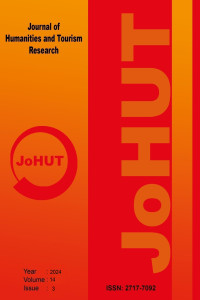Determining the Geotourism Potential of Tokat Gökçeli Dilim Kayalar through SOAR Analysis and Formulating Regional Development Strategies
Öz
This study evaluates the geotourism potential of Tokat Gökçeli Dilim Kayalar using the SOAR (Strengths, Opportunities, Aspirations, Results) analysis and develops regional development strategies based on the findings. The research is based on primary data collected through interviews with local government representatives, tourism academics, residents, and field observations. Key strengths identified include the region's unique geological structure, natural beauty, historical and mythological significance, suitability for nature sports, rich ecosystem, and local hospitality. Opportunities encompass access to new tourism markets, infrastructure development, effective promotion strategies, and sustainable tourism projects. Aspirations aim to establish the area as a leading nature tourism destination, revitalize the local economy, become a center for ecotourism, and preserve natural and cultural heritage. Results indicate potential increases in tourist numbers, economic benefits, adoption of sustainable tourism practices, and improvements in tourism infrastructure. This research provides a comprehensive roadmap for leveraging the geotourism potential of Tokat Gökçeli Dilim Kayalar, benefiting both academic and practical applications.
Anahtar Kelimeler
Geotourism Sustainable Tourism Dilim Kayalar SOAR Analysis Development Strategies
Kaynakça
- Ağca, Y., & Gündüz, C. (2023). Türkiye’deki otel konuk yorumları ve puanlarının metin madenciliği ile analizi. Yönetim ve Ekonomi Dergisi, 30(2), 397-411.
- Bendixen, M., & Andries, N. (2016). Hoodoo erosion and formation processes in arid and semi-arid regions. Geomorphology Journal, 255, 12-25.
- Bryman, A. (2012). Social research methods (4th ed.). Oxford University Press. Buckley, R. (2012). Sustainable tourism: Research and reality. Annals of Tourism Research, 39(2), 528- 546.
- Buhalis, D., & Amaranggana, A. (2013). Smart tourism destinations. In Z. Xiang & I. Tussyadiah (Eds.), Information and communication technologies in tourism 2014 (pp. 553-564).
- Springer Cham. Buhalis, D., & Costa, C. (2006). Tourism business frontiers: Consumers, products and industry. Elsevier. Butler, R. W. (1980). The concept of a tourist area cycle of evolution: Implications for management of resources. Canadian Geographer, 24(1), 5-12.
- Cascade Strategy. (2024). SOAR analysis: What it is & step-by-step guide. https://www.cascade.app/soar-analysis Chamboko-mpotaringa, M. C., & Tichaawa, T. M. (2023). Domestic tourists’ perceptions of the intention to use digital marketing tools and platforms. GeoJournal of Tourism and Geosites, 46(1), 9-18.
- Chakrabarty, P., & Mandal, R. (2018). Geotourism mapping for sustainability: A basin-oriented approach. GeoJournal of Tourism and Geosites, 21(1), 174-185.
- Creswell, J. W. (2013). Qualitative inquiry and research design: Choosing among five approaches (3rd ed.). Sage Publications. Dodds, R., & Butler, R. (2009). Barriers to implementing sustainable tourism policy in mass tourism destinations. TOURISMOS: An International Multidisciplinary Journal of Tourism, 5(1), 35-53.
- Dowling, R. K., & Newsome, D. (2006). Geotourism. Oxford: Elsevier.
- Dredge, D., & Jenkins, J. (2007). Tourism planning and policy. John Wiley & Sons. Dritsakis, N. (2004). Tourism as a long-run economic growth factor: An empirical investigation for Greece using causality analysis. Tourism Economics, 10(3), 305-316.
Tokat Gökçeli Dilim Kayalar'ın Jeoturizm Potansiyelinin SOAR Analizi ile Belirlenmesi ve Bölgesel Kalkınma Stratejilerinin Oluşturulması
Öz
Bu çalışma, Tokat Gökçeli Dilim Kayalar'ın jeoturizm potansiyelini SOAR (Güçlü Yönler, Fırsatlar, Hedefler, Sonuçlar) analizi kullanarak değerlendirmekte ve bulgulara dayalı bölgesel kalkınma stratejileri geliştirmektedir. Araştırma, yerel yönetim temsilcileri, turizm akademisyenleri, yerel halk ve saha gözlemleriyle yapılan görüşmeler aracılığıyla toplanan birincil verilere dayanmaktadır. Belirlenen temel güçlü yönler arasında bölgenin benzersiz jeolojik yapısı, doğal güzelliği, tarihi ve mitolojik önemi, doğa sporlarına uygunluğu, zengin ekosistemi ve yerel misafirperverlik yer almaktadır. Fırsatlar, yeni turizm pazarlarına erişim, altyapı geliştirme, etkili tanıtım stratejileri ve sürdürülebilir turizm projelerini kapsamaktadır. Hedefler, bölgeyi önde gelen bir doğa turizmi destinasyonu olarak konumlandırmayı, yerel ekonomiyi canlandırmayı, ekoturizm merkezi olmayı ve doğal ve kültürel mirası korumayı amaçlamaktadır. Sonuçlar, turist sayısında potansiyel artışlar, ekonomik faydalar, sürdürülebilir turizm uygulamalarının benimsenmesi ve turizm altyapısındaki iyileşmeleri göstermektedir. Bu araştırma, Tokat Gökçeli Dilim Kayalar'ın jeoturizm potansiyelinden yararlanmak için akademik ve pratik uygulamalara fayda sağlayacak kapsamlı bir yol haritası sunmaktadır.
Anahtar Kelimeler
Jeoturizm Sürdürülebilir Turizm Dilim Kayalar SOAR Analizi Kalkınma Stratejileri
Kaynakça
- Ağca, Y., & Gündüz, C. (2023). Türkiye’deki otel konuk yorumları ve puanlarının metin madenciliği ile analizi. Yönetim ve Ekonomi Dergisi, 30(2), 397-411.
- Bendixen, M., & Andries, N. (2016). Hoodoo erosion and formation processes in arid and semi-arid regions. Geomorphology Journal, 255, 12-25.
- Bryman, A. (2012). Social research methods (4th ed.). Oxford University Press. Buckley, R. (2012). Sustainable tourism: Research and reality. Annals of Tourism Research, 39(2), 528- 546.
- Buhalis, D., & Amaranggana, A. (2013). Smart tourism destinations. In Z. Xiang & I. Tussyadiah (Eds.), Information and communication technologies in tourism 2014 (pp. 553-564).
- Springer Cham. Buhalis, D., & Costa, C. (2006). Tourism business frontiers: Consumers, products and industry. Elsevier. Butler, R. W. (1980). The concept of a tourist area cycle of evolution: Implications for management of resources. Canadian Geographer, 24(1), 5-12.
- Cascade Strategy. (2024). SOAR analysis: What it is & step-by-step guide. https://www.cascade.app/soar-analysis Chamboko-mpotaringa, M. C., & Tichaawa, T. M. (2023). Domestic tourists’ perceptions of the intention to use digital marketing tools and platforms. GeoJournal of Tourism and Geosites, 46(1), 9-18.
- Chakrabarty, P., & Mandal, R. (2018). Geotourism mapping for sustainability: A basin-oriented approach. GeoJournal of Tourism and Geosites, 21(1), 174-185.
- Creswell, J. W. (2013). Qualitative inquiry and research design: Choosing among five approaches (3rd ed.). Sage Publications. Dodds, R., & Butler, R. (2009). Barriers to implementing sustainable tourism policy in mass tourism destinations. TOURISMOS: An International Multidisciplinary Journal of Tourism, 5(1), 35-53.
- Dowling, R. K., & Newsome, D. (2006). Geotourism. Oxford: Elsevier.
- Dredge, D., & Jenkins, J. (2007). Tourism planning and policy. John Wiley & Sons. Dritsakis, N. (2004). Tourism as a long-run economic growth factor: An empirical investigation for Greece using causality analysis. Tourism Economics, 10(3), 305-316.
Ayrıntılar
| Birincil Dil | İngilizce |
|---|---|
| Konular | Ekoloji, Sürdürülebilirlik ve Enerji, Turizm (Diğer) |
| Bölüm | MAKALELER |
| Yazarlar | |
| Yayımlanma Tarihi | 30 Eylül 2024 |
| Gönderilme Tarihi | 25 Ağustos 2024 |
| Kabul Tarihi | 3 Eylül 2024 |
| Yayımlandığı Sayı | Yıl 2024 Cilt: 14 Sayı: 3 |


